Educational Programme
Ennistymon '84 was, in itself, an educational program- me. Beginning in October 1983 and running through to early 1985, the committee organised over one hundred events in the town, each intended to bring about a greater awareness of art as a positive element in day-to-day life through participation and confrontation at all levels.
Other chapters in this report highlight specific projects which, to a certain degree, stand on their own feet. This chapter therefore synopsises the "other" events, mostly one-day or short-term happenings, which together accounted for over fifty of the total organised events, and which hopefully will act as a basis for a continuing "art-presence" in the town in future years.
Excluding the period of the Festival (Aug. 13-31), the years events comprised:
13 exhibitions;
11 workshops 9 lectures;
5 public meetings;
3 poetry readings;
2 childrens paint-ins;
and a variety of individual events including:
Druid Theatre's "Famine";
Seminar on "Contemporary Art";
"Fashion Frolics" for teenagers; Childrens Poster Competition; Schools Architectural Project; Harp Recital; Bus Tour of the Burren; Songs of John McCormack; Dublin Contemporary Dance Theatre; Children's Puppet Show; Etc. (See 'Chronology of Events' for details).
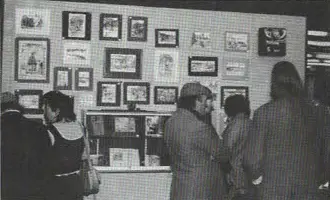
Anna Korff and Chris Walker, two local based artists exhibited their work at the Library in April
EXHIBITIONS
The exhibitions fell into two categories:
(a) contemporary work of local and locally based artists, (b) collections of local artefacts.
(a) The exhibitions by local artists brought a mixed response, from very well received to hardly noticed. Selection of works for display and availability of venues were important factors with regard these exhibitions, and the most successful venue appears to have been the Arts/Information Office (See separate Chapter). Here was a venue which could host a display without any conflict of use within the building, and was the nearest we came to a true gallery space. Other venues for these exhibitions were the library and the local branches of Allied Irish Banks and Bank of Ireland each of which have their own particular "distractions" which take from displays of art. Nonetheless, these exhibitions were for many people their first glimpse of the work of artists who have been quietly beavering away in the locality for many years, and who might otherwise have remained unnoticed. With regards the artists' selection of work for their exhibitions, it is perhaps not surprising that abstract work was less favourably received by local audiences than the more conventional, recognisable work.
It should be mentioned here that the onus was on the artists themselves to organise the transportation and hanging of their own shows, with assistance from the Committee. In most cases this worked very well and the artists involved were most co-operative. In some cases, a simple 'opening' ceremony was organised, depending on the wishes of the artist; and in one case a full formal launching was organised by the artist himself with the minimum of assistance from the committee. In this way expenditure of Ennistymon '84 funds was kept respectively low.
(b) The second type of exhibition, that of collections of local artefacts proved to be hugely popular. Indeed the exhibition of local photographs in January proved to be the most successful advertisement for the whole project. The format for these exhibitions ('Old Photos', 'Local Textiles', and 'Printed Matter') was much the same in that people from the town and locality were asked to loan items of interest from their own collections, which would be displayed (with care and respect) alongside other pieces of social, historical (and of course, artistic) interest. Response was fantastic in all cases, and some real "gems" were unearthed. In the exhibition of photo- graphs, some of the local pictures (including a print on tin) dated back to the beginnings of photography. There were photos of Ennistymon after it was burned by the Black and Tans in 1920; there was a photo of an Ennistymon shop bearing an advert for sailings on the Titanic in 1912; and a touching picture of a young Ennistymon soldier leaving on the West-Clare Railway to fight in France during World War 1. In the exhibition of local textiles there were samples of flax-and linen made from it-which was grown in the area in the 19th century. And the exhibition of Printed Matter unearthed a host of posters, billheads and newspaper cuttings from the turn of the century and later years.
These were obviously "emotional" exhibitions, appealing to a sense of reminiscence and nostalgia, but at the same time people were viewing some of the best of local craft and quality goods, many of which owed more to the artist and craftsman than to the merchant or businessman.
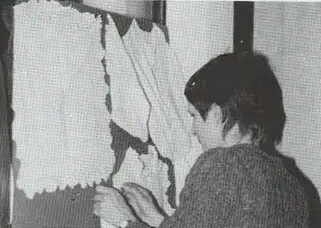
Local-made lace from linen displayed at the Library
WORKSHOPS
Most of the workshops were run at weekends, usually meaning a full day on Saturday and a few hours on Sunday afternoon.
Generally speaking, and despite good advance publicity in the parish newsletter and The Clare Champion', and through posters locally, attendances at weekend workshops were small. This naturally made for more intimate and productive classes, though the lack of response to these events was somewhat worrying. Reluctance to attend can probably be put down to the inhibitions of adults to try something new. On the other hand, those who did attend were more than pleased with the tutoring of the artists, and presumably their appreciation was improved. Some expressed a wish that a favourite workshop would continue in winter time when there would be more time to attend.
The most successful workshops were, not surprisingly, those organised for the young children in pottery and puppetry. In each case, about 100 youngsters flocked to the venue, and their work rate and appreciation were encouragingly high. Perhaps the most surprising success was that of two workshops in dance, mime and movement. Theatre Omnibus ran a series of weekday classes for a number of weeks in June/July, and the Dublin Contemporary Dance Theatre held a workshop after its performance in November. All classes were very well attended. We are particularly indebted to Bernard and Jean of Theatre Omnibus for the time, energy and encouragement which they gave to their own sessions and to the project in general, very often without financial gain or reward.
The other workshops held were: Dyeing Techniques, Sculpture for Teenagers, Lino-cut Printing, Dry-Point Etching, Puppet-making, Macrame and Kite-Making. For most of the workshops the artists were from North-Clare and the committee is eternally grateful to all who gave their time and services free of charge. Participants in the classes were charged a small fee which generally went towards the cost of materials used. In some instances these nominal fees were waived altogether, and Ennistymon Youth Club also sponsored some of its members to attend.
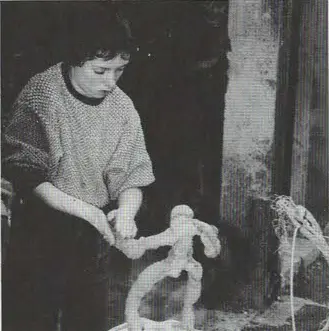
LECTURES
Lectures might be considered an ideal way of imparting information and stirring interest, and certainly we had an informed and interesting troupe of lectures during the year. Nonetheless, this series of lectures tended to fall on deaf ears as audiences were generally fair to poor. Perhaps it was expecting too much to hope that the Ennistymon public would flock to hear monologues on such diverse topics as "Art in Public Places", or "Towards an Arts Policy", or "Religious Icons". Indeed as the year went on and the summer neared, we realised it was pointless to continue with the series of lectures. Firstly, they were best attended during the winter months; and secondly, the subject matter had to be popular otherwise the locals stayed away.
By contrast, the success of the lecture series in terms of attendance was that by Mary Angela Keane on the "Botany of the Burren". Over sixty people, including children, locals and tourists, squeezed into the Arts/ Information office on a damp July evening. The takings here were good, by comparison with most of the other lectures which either broke even or lost money.
PUBLIC MEETINGS
As with the lectures, the early ones were best attended while the later ones elicited a poorer response. As already stated (General Introduction) the first public meeting which launched the project was an unparalleled success. Further meetings failed to bring the same, or new, faces out of the woodwork, although a few stalwarts were with us to the end. It was as if, once established, the committee was left to do it all itself. In some ways this was flattering, but in other ways disappointing, as there are "key" people in the community who hold important sway within their own groups, but who were reluctant at
times to share their expertise. Of course, we could have charged ahead without ever holding another public meeting, but our catch-cry of "Are we reaching enough - people?" continuously reared its head, and so we repeatedly sought to attract new blood. We were often told that local people always were adverse to such forums, and in practice, we found there was more to be gained from working on the ground through "traditional" channels than from hosting meetings for a sparsely populated room of the already-converted.
POETRY READINGS
Readings by Michael Hartnett, Knute Skinner and Eddie Lenihan were all well received. The first was held in the Falls Hotel, where the noise from the kitchen and the aroma of food almost distracted the audience. Following the reading, the local Comhaltas group played out the night. The other two readings were held at the library. This time-unlike the art exhibitions-the venue proved most suitable and not in the least distracting for an evening of poetic indulgence.
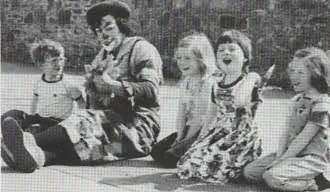
Bernard of Theatre Omnibus entertaining
CHILDREN'S PAINT-INS
In contrast to adult-orientated events, all the children's events were attended in great numbers and with endless enthusiasm. 'Paint-Ins' were held at Christmas and Easter during the school holidays. The first was organised with the assistance of local artists who painted with the children and generally coaxed and cajoled them into experimenting with colours and designs. The second combined painting with three-dimensional shapes, as well as pavement art. The fun element was enhanced by the 'surprise' visit of Theatre Omnibus. Bernard was painted from head to toe..!
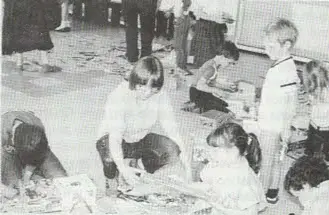
OTHER EVENTS
The year catered for all sorts of interests, and threw up a variety of colourful events:
Druid Theatre's "Famine": A full house at the Centre, Lahinch. Not surprisingly we could have sold out two or three performances.
Seminar on "Contemporary Art": Paul O'Reilly manipulated three slide projectors at once to captivate a small but delighted group.
"Fashion Frolics": The Library filled with teenagers. A fashion parade by the students from the Limerick College of Art and Design was followed by a parade of young local designers. In one corner a hair-stylist was in full flight; while in another, a local beautician had no shortage of volunteers for make-up. And all the time there was music, and minerals, and quite a buzz.
Children's Architectural Project: Drawn up on the lines of a similar project in Cork, for implementation in the secondary schools.
Harp Recital: On a wet June evening, Maire Ni Chathasaigh enchanted the audience at the local Parish Church. This was another new venue' but it proved somewhat too big for the occasion. Nonetheless, the recital is remembered with fondness.
Bus Tour: Prof. Etienne Rynne led the intrepid explorers through a misty Burren in search of Ancient Sites. Rain spoiled play, although the Dane at the back didn't seem to mind as he did some exploring of his own ..!
Songs of John McCormack: "Remembering You", a recital by Stephen O'Shea with Colette Davis, received a warm reception from a warm audience.
Dublin Contemporary Dance Theatre: Late in November, this was almost a P.S. to the year. A disappointing audience, though not disappointed. The workshop the following day fared somewhat better.
Children's Puppet Show: Hard to tell the children from the puppets as about one hundred youngsters filled the Credit Union House for a hearty performance. This was children entertaining themselves, it couldn't but succeed.
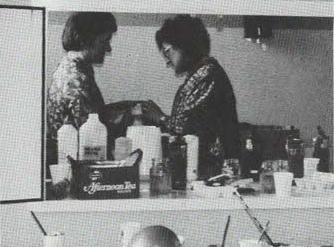
THANKS TO:
Mike and Lisa O'Connor Michael John Glynn Ennistymon Library Staff
Dermot Twohig
Clare Champion
Matt O'Connell
Mary Grey
Naoise Cleary
Fr. Denis Crosby
Tom O'Connell
Manus Walsh
Pat Barrett
Falls Hotel
Allied Irish Bank
Bank of Ireland
Credit Union
Comhaltas Ceoltoiri
Jerome Hynes
Druid Theatre Co.
Paul O'Reilly
Pam McCarthy
Limerick School of Art and
Design
David Browne
Neilus O'Doherty
C.B.S.
Convent of Mercy
Vocational School
Maire Ni Chathasaigh
Stephen O'Shea Noel Doyle
Ilsa Thielan
Pauline Fitzgerald
Helen Flanagan
Frank Henchy
Anne Korff
Chris Walker
Carmel Kenny Yvonne Bartlett
Kitty Timmins Terry Leahy
Theatre Omnibus
Gail Courtney
David Riordan
Richard Sharpe
Brian Bourke
Jay Murphy Hugh Weir
Maire de Paor
Canon P. O'Laoi
Fred Bazler
Michael D. Higgins
Tom Munnelly
Prof. Etienne Rynne
Maryangela Keane
Colette Davis
Dublin Contemporary
Dance Theatre
Paddy O'Dwyer
Michael Glynn Voluntary Service International
Rita Vaughan
Dodo Mackey Andy Hehir
Margaret Teehan
Catherine O'Loughlin